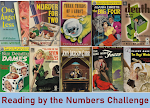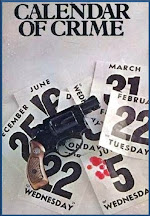"And that," Judith Appleby said, "must be Scroop House." She took her finger from the map and pointed across the valley. (The Crabtree Affair, 1962)
"It's wonderful to have a little peace and quiet for a change," Owain Allington said. "And particularly when it takes the form of a congenial tête-â- tête." (Death by Water, 1968)
Mr. Robert Appleby (successful scrum-half retired, and author of that notable anti-novel The Lumber Room) fixed his gaze for a full thirty seconds on the flag on the first green. (An Awkward Lie, 1971)

The Povey brothers eyed one another. Charles Povey's gaze was more fixed than Arthur Povey's--which was in the nature of things, since Charles was dead. (The Gay Phoenix, 1976)
I can't say that the first two struck me as enticing beginnings to mystery stories. Although, I'm sure if experience is anything to go by--Scroop House is going to figure prominently in the The Crabtree Affair and Owain Allington is probably going to find his peace and quiet disturbed quite soon in Death by Water. Each of the last two features a nicely fixed gaze and I found myself more intrigued by that of the poor, dead Charles. Was the promise of that opening bit fulfilled? We shall see....
Charles and Arthur Povey set out on a boating adventure. Charles is the rich brother who can afford to keep a yacht and Arthur is the less affluent brother with the sailing skills. His skills prove useless, however, when they run into a storm which leaves the boat mast-less and one brother dead (courtesy of the falling mast). When the remaining brother is picked up and brought to the hospital in Adelaide, Australia, he seems a bit delirious and insists that he is Arthur. But all the physical evidence (including a missing index finger) seems to prove that the survivor is actually Charles. The doctors actually seem (as Povey puts it) to "bully" him into being Charles. So, who really survived? Has Arthur, as he has been wont to do throughout his life, taken advantage of a golden opportunity to slip into a more cushy way of life? Has he pulled a double-bluff--forcing the doctors to change his identity for him? And, if so, will he get away with it scot-free? It would seem not--people from the brothers' past keep popping up--with blackmail on their minds. They all want a ride on the gravy train--hush money to keep them from telling what they know. About Arthur. About Charles. And about somebody else called Alcorn.
And then there's retired detective Sir John Appleby. He just happens to live in the area where Arthur/Charles winds up going to ground (at the instigation of a few of those blackmailing folks). Appleby is at loose ends with little to keep him occupied and his new neighbor draws his attention. What little he finds out about him reminds Appleby of a story a doctor in Australia told (with names change to protect the "innocent") and the retired detective's instincts tell him there's more to the story than meets the eye. He finally figures out which brother survived....or does he?
The Innes detective novels have a way of veering off the beaten mystery path. This is one of the more bizarre offerings and I must admit it's not really my cup of tea. We know from the beginning what happened and to whom/by whom (or do we?) and we're waiting throughout the novel to see if Povey will be exposed. But the journey to the end isn't particularly interesting or engaging to the crime fiction fan. The best bits are the portions devoted to Appleby and his wife. Lady Appleby is a lovely character and the book is worth it just for her interactions with Jane Birch-Blackie in the in Linger Stores. Not exactly my idea of a detective story--but a fairly good character study. ★★
As mentioned above, this fulfills the "TBR First Lines" square on the Silver Vintage Bingo card. Written in 1976, it also provides one more entry for Rich's Crimes of the Century feature for September. This month is focused on crime fiction from 1976. Got mysteries from 1976 that you can read and review? Come join us! For the purposes of Rich's feature--this one doesn't tell us much about 1976. A great many of Innes's novels don't really seem tied to a particular time--especially his more esoteric works. One almost feels that this odd little adventure could have taken place anywhere as much as anywhere else.































4 comments:
It might be too bizarre for me too. Great review!
I love the cover of the Penguin edition Bev - Innes remain an author I just must try again as I just didn;t seem to 'get' him at all and found them hard going frankly.
Sergio: I generally like Innes. But ever so often he goes too far off the rails and I don't get him either. This one is only saved by Appleby and his lady wife.
Sounds a bit odd, probably not one I'll try.
Post a Comment